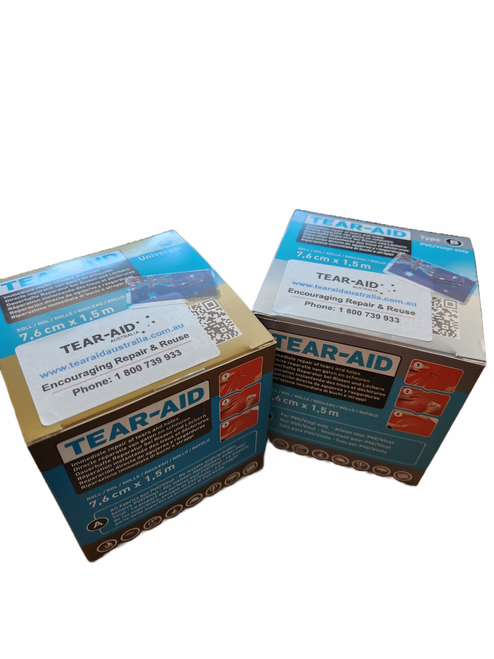-


Tear Aid
Vinyl Repair Roll (L) | Type B | Metre
R6,649.76 (Inc. GST)R6,045.14 (Ex. GST)Tear Aid One Metre Roll - Width 15.2cm Use to repair damaged Plasticised or Flexible PVC, Unplasticised or Rigid PVC, Chlorinated Polyvinyl Chloride or Perchlorovinyl (CPCV), Molecular Oriented PVC or PVC-O. Modified PVC or...
-

Tear Aid
Vinyl Repair Roll with Roller | Type B | 15.2cmx9m
R46,122.36 (Inc. GST)R41,929.66 (Ex. GST)Tear Aid Type B - 15.2cm x 9m + Silicone Roller - Precision Application & Maximum Adhesion For commercial, military, marine, and industrial repairs, this premium bundle combines the Tear Aid Type B Roll (15.2cm x 9m) with the Silicone Roller,...
-

Tear Aid
Canvas Repair Patch (L) | Type A | 15.2cm x 15.2cm
R2,169.02 (Inc. GST)R1,971.89 (Ex. GST)Canvas Repair Patch (L) - 15.2cm x 15.2cm - Maximum Coverage for Large-Scale Repairs The Canvas Repair Patch (L) provides extended surface coverage, making bigger repairs effortless and reliable. Designed for canvas, rubber, leather, and plastics, this...
-

Tear Aid
Vinyl Repair Patch (L) | Type B | 15.2cm
R2,169.02 (Inc. GST)R1,971.89 (Ex. GST)Single Tear Aid patch measures 15.2cm x 15.2cm. Use to repair damaged Plasticised or Flexible PVC, Unplasticised or Rigid PVC, Chlorinated Polyvinyl Chloride or Perchlorovinyl (CPCV), Molecular Oriented PVC or PVC-O. Modified PVC or...
-

Tear Aid
Canvas Repair Roll with Roller | Type A | 15.2cmx9m
R46,122.36 (Inc. GST)R41,929.66 (Ex. GST)Tear Aid Type A - 15.2cm x 9m + Silicone Roller - Precision Application & Maximum Versatility For commercial, military, marine, and industrial repairs across canvas, rubber, and non-oiled synthetic materials, this premium bundle combines the Tear Aid...
-


Tear Aid
Canvas Repair Roll (S) | Type A | Metre
R2,510.97 (Inc. GST)R2,282.65 (Ex. GST)Tear Aid One Metre Roll - Width 3.2cm Use to repair damaged Canvas, Rubber, Neoprene, Nylon, Plastics, Polyethylene, Polypropylene, Polyurethane, Polyester, Non-oiled Leather, Fibreglass, Aluminium, Hypalon and Dacron Included with this purchase are...
-


Tear Aid
Vinyl Repair Roll (S) | Type B | Metre
R2,510.97 (Inc. GST)R2,282.65 (Ex. GST)Tear Aid One Metre Roll - Width 3.2cm Use to repair damaged Plasticised or Flexible PVC, Unplasticised or Rigid PVC, Chlorinated Polyvinyl Chloride or Perchlorovinyl (CPCV), Molecular Oriented PVC or PVC-O, Modified PVC or PVC-M, Adhesive Vinyl, and Heat...
-

Tear Aid
Easy repair solutions for difficult jobs
R10,233.09 (Inc. GST)R9,302.90 (Ex. GST)Rather than throwing away the item and replacing it with a new one, repair it and save money. Choosing to repair instead of replacing also supports a circular economy as it promotes reuse and recycling - instead of disposal and waste. By having...
-

Tear Aid
Canvas and Gore-Tex Repair Roll with Silicone Pressure Roller
R8,633.80 (Inc. GST)R7,848.96 (Ex. GST)Tear Aid helps to reduce waste and keep items in continual circulation for as long as possible. Type A *Tear Aid can be used on: Canvas Rubber Neoprene Nylon Plastics, Polyethylene, Polypropylene, Polyurethane,...
Repair Solutions
Science, when used correctly, should not aim to dominate nature but rather live in harmony with it. Through scientific experimentation we have been able to create sustainable products that can aid in waste management and reduce our reliance on resources. Sustainability does not simply mean reducing harm but also striving to do better. One way to achieve this is by repairing items rather than purchasing new ones. Repairing products has several benefits, including cost savings, environmental sustainability, preserving familiarity and attachment, developing new skills, improving quality, and instilling a sense of independence. Repairing an item is often less expensive than buying a new one, especially for high-quality or specialty items, which can result in significant cost savings. Repairing items can reduce waste and conserve resources, which reduces the environmental impact on production and disposal. Many people have sentimental attachments to items they have owned for a long time. Repairing these items can help preserve those memories and connections while simultaneously developing new skills. By repairing items that are designed to be disposable, their lifespan can be extended, improving their overall quality, and reducing waste. Repairing items can instil a sense on independence, allowing individuals to feel self-sufficient and empowered, as they realise they can fix things themselves instead of relying on others. Repairing items with Tear Aid instead of purchasing new ones offers significant financial, environmental, and personal benefits. It is a sustainable and empowering practice that can help reduce waste, conserve resources, and develop new skills.
 RUB
RUB  Australia
Australia
 Europe
Europe
 United States
United States
 New Zealand
New Zealand
 Canada
Canada
 United Kingdom
United Kingdom
 Brazil
Brazil
 Romania
Romania
 UAE
UAE
 Brunei
Brunei
